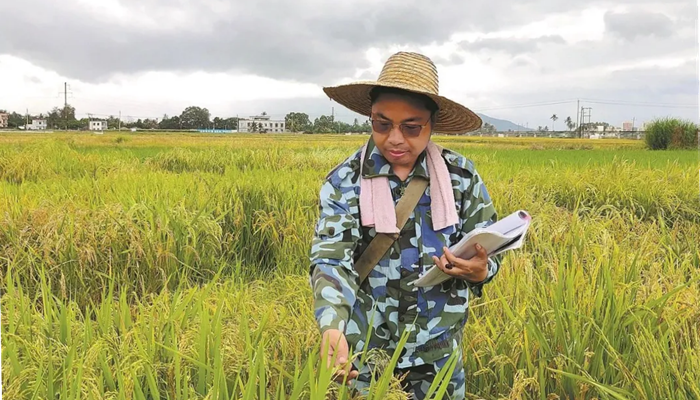
Zhang Guangheng checks the performance of hybrid rice seedlings in Hainan province. CHINA DAILY
In the 1950s, Chinese crop scientists would travel for many hours each winter from regions at higher latitudes to tropical locations such as South China's Guangxi Zhuang autonomous region and Hainan province.
Their journeys — using trains, buses and ships — could take days, but they were not heading south for vacations.
Instead, they flocked to warmer — but usually remote and poorly resourced — places to conduct trial planting of higher-yielding crop varieties.
Falling temperatures made such endeavors impossible at home.
Before new crop varieties are approved for commercial production, they need to go through multiple rounds of trial planting to ensure their favorable traits are sufficiently stable to be passed down through generations.
By making such trips, the researchers could avoid having trial plantings terminated by seasonal factors and shorten the process of perfecting new varieties by years, fast-tracking the commercialization of better-performing crop varieties to ease food shortages.
But such seasonal travel has become history in recent years.
Many agricultural institutes have moved their research bases to Sanya, a resort city on the southern tip of Hainan Island better known for its palm trees, luxury hotels and duty-free shops.
Zhang Guangheng, who graduated from an agricultural university in Zhejiang province in 1996, was one of the many plant scientists who used to make such trips each year.
He visited Hainan for the first time in the winter of 1997 as a seed quality controller at the China National Rice Research Institute, based in Zhejiang's provincial capital, Hangzhou.
He carried a large trunk, sealed with a label bearing the red stamp of his employer, that contained several different varieties of hybrid rice seeds waiting to be planted in experimental fields to see if their quality was up to standard.
"I usually arrived in November to plant such seeds," Zhang said. "The test results would determine if such seeds would be used in the rice planting season in April."
For decades, Sanya served as his wintertime testing ground.
When spring brought higher temperatures to Hangzhou, Zhang, who later became a rice breeding expert, would return to his better-equipped laboratory there to analyze data, produce papers and attend seminars.
"That was the routine for almost all my career till recent years, when many research bodies set up breeding complexes in Sanya," he said, adding that well-equipped breeding laboratories, germplasm banks and other state-of-the-art research facilities have mushroomed in Sanya since 2018.
Zhang now conducts research at a laboratory in Sanya owned by the Chinese Academy of Agricultural Sciences, a partner of the rice research institute, and spends more than eight months a year there.
Zhang is among a growing number of plant breeding experts who are spending more of their working hours in Hainan as the central authorities seek to remold Sanya into a global agricultural research hub whose importance in the farming world could rival that of Silicon Valley in the tech industry.
Thanks to the island's visa-free policy, tropical climate, biodiversity and cutting-edge research facilities, it is becoming a major draw for rice researchers from around the world — and especially those from Africa.
"I expect more cooperation with researchers from Africa and Southeast Asia," Zhang said. "Sanya will give them access to some of the best research facilities and help them address food problems back home."
地址:海南省三亚市崖州区金稻路5号 邮编:572024 邮箱:nanfanyuan@caas.cn 电话:0898-38288010
Copyright © 中国农业科学院 京ICP备10039560号-5 京公网安备11940846021-00001号
技术支持:中国农业科学院农业信息研究所

